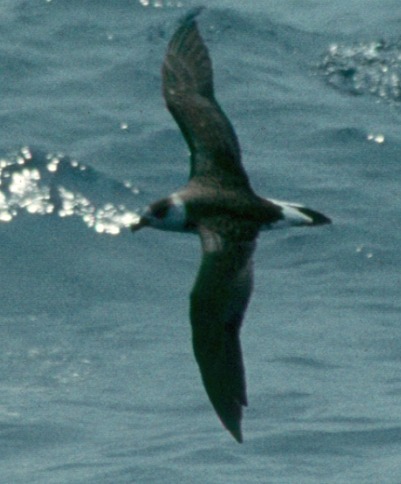|
Black-capped Petrel Pterodroma hasitata Diablotín
|
 |
|
Photo: M. Donahue
|
|
IDENTIFICATION: An agile seabird with a black cap, back and tail; and white undersides, neck, forehead, and rump patch. Length: 40 cm.; weight: 138-242 g. VOICE: Not vocal when feeding or traveling at sea, but makes an eerie, groaning noise when on its remote mountain nesting grounds. The Spanish and French names for the Black-capped Petrel reflect this diabolical sound and its nocturnal habits. HABITAT: Nests on remote, steep mountain cliffs primarily on Hispaniola. Spends most of the year at sea over deep waters, especially the edge of the Gulf Stream. HABITS: The Black-capped Petrel has a distinctive, arcing flight close to the sea surface. At the top of the arc, it tilts to the side so that one wing is almost completely pointed downward. It feeds on fish, squid and other marine invertebrates close to the surface, especially near upwellings of ocean water, current boundaries, and turbulence. During the nesting season from November to May, the petrel is difficult to detect because it flies in from the sea to its mountain nesting cliffs in darkness. The nest is a long burrow (1-3 meters deep) and contains one egg. STATUS AND CONSERVATION: The Black-capped Petrel’s total breeding population is probably only 1,000-2,000 pairs. This bird once bred on Guadeloupe, Dominica and Martinique, but was wiped out a century ago. Its remaining breeding grounds were unknown until nesting colonies were found on steep, forested cliffs on Hispaniola. This petrel has been reported only a few times from Puerto Rican waters. Since it feeds far out at sea, it may be more frequent than is commonly recognized, especially in winter and spring when breeding occurs on Hispaniola. The species is threatened by deforestation, burning, overgrazing, and soil erosion at its nesting sites. Rats, mongooses, dogs, and cats, as well as hunting by humans, threaten some nesting colonies. RANGE: Known to nest on Hispaniola. It may still nest on Cuba, Dominica and on other Caribbean islands as well, but nesting is difficult to detect because of remote cliff locations and nocturnal breeding habits. When not nesting, this species ranges through the northern Caribbean and the southern Gulf Stream to waters off coastal Virginia. TAXONOMY: PROCELLARIIFORMES; PROCELLARIIDAE. The related Bermuda Petrel (Pterodroma cahow), a rare visitor to deep water off North Carolina, breeds on islets off Bermuda and may show up in the Caribbean eventually. Compared to the Black-capped Petrel, it lacks the white hindneck. (http://www.irf.org/bcahow.htm; http://fog.ccsf.cc.ca.us/~jmorlan/bepe.htm). |
|
 |
|
|
Photo: G. Beaton
|
 |
|
Photo: C. Haney
|
|
References BirdLife International. 2000. Threatened birds of the world. Lynx Edicions and BirdLife International, Barcelona and Cambridge, UK. Collar, N.J., L.P. Gonzaga, N. Krabbe, A. Madronno Nieto, L.G. Naranjo, T.A. Parker III, and D.C Wege. 1992. Threatened birds of the Americas: The ICBP/IUCN red data book, 3rd edition, part 2. Smithsonian Institution Press, Washington, D.C. del Hoyo, J., A. Elliott, and J. Sargatal, eds. 1992. Handbook of Birds of the World, Vol. 1, Lynx Edicions, Barcelona. Douglas, L. 2000. Status of the Jamaican Petrel in the West Indies. Pp. 19-24 in Status and conservation of West Indian seabirds (E. A. Schreiber and D. S. Lee, eds.). Soc. Carib. Ornith., Special Pub. No. 1. Erdman, D.S. 1967. Seabirds in relation to game fish schools off Puerto Rico and the Virgin Islands. Carib. J. Sci. 7:78-85. Harrison, P. 1983. Seabirds: an identification guide. Houghton Mifflin, Boston. Harrison, P. 1987. A field guide to seabirds of the world. Stephen Greene Press, Lexington, MA. Lee, D. S. 2000. Status of and conservation priorities for Black-capped Petrels in the West Indies. Pp. 11-18 in Status and conservation of West Indian seabirds (E. A. Schreiber and D. S. Lee, eds.). Soc. Carib. Ornith., Special Pub. No. 1. Platania, S. P., G. S. Grant, and D. S. Lee. 1986. Core temperatures of non-nesting Western Atlantic seabirds. Brimleyana 12:13-18. Raffaele, H.A. 1989. A guide to the birds of Puerto Rico and the Virgin Islands. Princeton. Raffaele, H.A. 1989. Una guía a las aves de Puerto Rico y las Islas Vírgenes. Publishing Resources, Inc., Santurce, PR. Raffaele, H.A., J.W. Wiley, O.H. Garrido, A.R. Keith, and J.I. Raffaele. 1998. Guide to the birds of the West Indies. Princeton. Regalado Ruíz, P. 1998. Nueva localidad para la distribución del Pterodroma hasitata (Aves: Procellaridae). El Pitirre 11(1):14-15. Schreiber, E. A. and D. S. Lee. 2000. West Indian seabirds: a disappearing natural resource. Pp. 1-10 in Status and conservation of West Indian seabirds (E. A. Schreiber and D. S. Lee, eds.). Soc. Carib. Ornith., Special Pub. No. 1. Schreiber, E. A. 2000. Action plan for conservation of West Indian seabirds. Pp. 182-191 in Status and conservation of West Indian seabirds (E. A. Schreiber and D. S. Lee, eds.). Soc. Carib. Ornith., Special Pub. No. 1. Wiley, J. W. 2000. A bibliography of seabirds in the West Indies. Pp. 192-225 in Status and conservation of West Indian seabirds (E. A. Schreiber and D. S. Lee, eds.). Soc. Carib. Ornith., Special Pub. No. 1. Wingate, D.B. 1964. Discovery of breeding Black-capped Petrels on Hispaniola. Auk 81:147-159. WatchList: http://www.audubon.org/bird/watch/bcp/bcp.html. Black-capped Petrel, Spanish text Next species in taxonomic order Previous related species in taxonomic order |
|